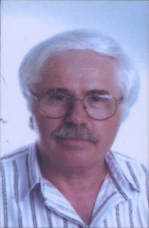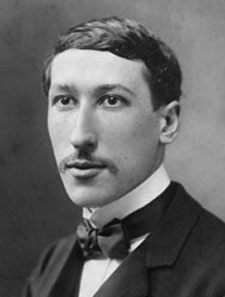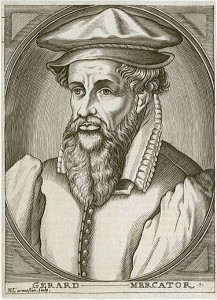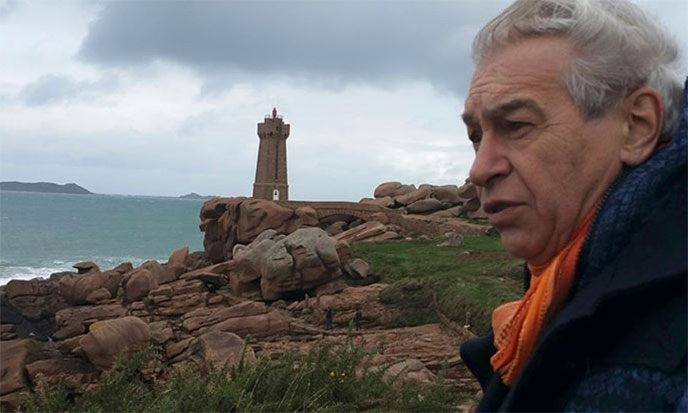Hyperborea
Séguin, Xavier
Xavier Séguin (1949- ) is the French author of the Eden Saga website(a). We have encountered Séguin in Atlantipedia in relation to a number of subjects. Some of his ideas are, in my opinion, simply daft. For example, he suggests that megalithic dolmens and menhirs can generate vril energy, which can be used to expedite the maturing of wine(b)!
The most exotic suggestion regarding the Etruscans comes from Séguin, who has claimed that they share a common ancestry with the Yoruba of West Africa, as both originated in Atlantis(c), a concept ‘borrowed’ from Leo Frobenius. He also offered a most extreme theory regarding the Olmecs with the claim that they were astronauts. This idea was expressed(d) by Séguin, quoting US astronaut Gordon Cooper [1757]!
However, I considered Séguin to be totally unreliable when I found that he also quoted a fictional character, Professor Mortimer, from a work by the renowned writer, Edgar P. Jacobs, as supposedly uttered by a real scientist(e), in relation to the Pillars of Heracles.
He denies that Atlantis was situated on the floor of the Atlantic, instead he proposes that Atlantis, Punt, Mu and Hyperborea had all been satellites(f)! Similar ideas were put forward Dieter Bremer.
(a) Sources Archives – Eden Saga – english (eden-saga.com)
(c) http://eden-saga.com/en/survivors-from-atlantis-frobenius-sixteen-gods-oracle-of-fa.html
(d) http://eden-saga.com/en/gordon-cooper-finds-olmecs-deep-knowledge-in-astronautics.html
Chiereghin, Luciano
Luciano Chiereghin is an Italian researcher who has a great interest in the history of the Po Valley, both  ancient and modern. In his 2007 book Atlantide al Microscopio (Atlantis Under the Microscope)[1572] he has the plain of the Valley as the location of Atlantis (=Hyperborea) and specifically the ancient town of Adria. He also proposes that Majorca, Sardinia, Corsica, Sicily, Crete and the Peloponnese constituted the island territories of Atlantis.
ancient and modern. In his 2007 book Atlantide al Microscopio (Atlantis Under the Microscope)[1572] he has the plain of the Valley as the location of Atlantis (=Hyperborea) and specifically the ancient town of Adria. He also proposes that Majorca, Sardinia, Corsica, Sicily, Crete and the Peloponnese constituted the island territories of Atlantis.
However, he is not the only one to link this region with Atlantis, as Morven Robertson published a book[1164] in 2015 with a similar theme. Both authors were drawn to the Po Valley by its size and its proximity to the magnificent mountains of the Alps, which protect the plain from the northern winds.
Diego Marin has favourably reviewed Chiereghin’s book(a).
(a) Atlantide al microscopio – Il sito ufficiale di diego marin (archive.org)*
Iceland *
Iceland has occasionally entered the Atlantis debates. Jean Silvain Bailly and more recently Gilbert Pillot  have identified Iceland with Ogygia. Some have linked the island with Thule or Hyperborea, while others see it as a remnant of a transatlantic landbridge. Harry Dale Huffman has similar ideas but believes that the landbridge also held Atlantis.
have identified Iceland with Ogygia. Some have linked the island with Thule or Hyperborea, while others see it as a remnant of a transatlantic landbridge. Harry Dale Huffman has similar ideas but believes that the landbridge also held Atlantis.
A recent commentator, Johan Nygren, also considered Iceland, when occupied by Cro-Magnon Man, to have been home of Atlantis(a)(b). This he followed with another paper drawing attention to the similarities between a map of Greenland and the famous 17th-century map of Atlantis published by Athanasius Kircher. More confusion was caused by an earlier document(c) in which he decided that South America was Atlantis and has since had it removed from the internet!
Another recent advocate for an Icelandic location is June Austin in a lengthy blog, which wanders all over the place, including the claim that a disproportionately large number of Icelandic people have psychic abilities(d). Sadly, she offers nothing but speculation to support her theory.
(a) https://steemit.com/atlantis/@johan-nygren/iceland-as-atlantis-2-0
(c) Having discovered the myth of Atlantis in the past days, I’ve now conformed to that it described South America (“Isla Atlantica”) — SteemKR (archive.org) (link now broken!)
Mooney, Richard E. (L)
Richard E. Mooney was one of a number of authors who followed in the footsteps of Erich von Däniken with a couple ‘ancient astronaut’ books. His first, Colony: Earth[0842], has a chapter devoted to Atlantis in which he gives qualified support to the Minoan Hypothesis.
In his sequel, Gods of Air and Darkness[1078], he again touches on the subject of Atlantis, although in a slightly more muted fashion. Nevertheless, he refers to the Greek legends of Atlantis and Hyperborea as being “both obviously based on fact.” (p.183)
Guénon, René
 René Guénon (1886-1951) was a noted French esotericist who was strongly influenced by Eastern mysticism, becoming a Sufi Muslim in 1912.
René Guénon (1886-1951) was a noted French esotericist who was strongly influenced by Eastern mysticism, becoming a Sufi Muslim in 1912.
He made a clear distinction between Hyperborea and Atlantis placing the former in the north and the latter submerged in the Atlantic, to the west. His book, Atlantide et Hyperborée, was recently republished [2064].
An overview of his life and work is available online(a).
Frisland
Frisland is the name given to one of the legendary islands of the North Atlantic, ‘located’ just south of Iceland. The story goes that it was discovered around 1380 by the Venetian, Nicolo Zeno (1326-1402) and that a record of his adventures there, together with a now-famous map (see below), was published in 1558 by a descendant. A decade later the celebrated Flemish cartographer, Gerardus Mercator (1512-1594), published a comparable map, which also showed Frisland at much the same location and with a similar outline. Cornelius Wytfliet produced a map of the North Atlantic in 1597 depicting Frisland at the same location(c). It did not take long for doubts to be expressed about both the map and its accompanying narrative. Donald S. Johnson in his excellent Phantom Islands of the Atlantic[0652] concluded that Frisland was probably a case of ‘mistaken identity’, incorporating “the geography of the Faroe Islands and the contour of Iceland.”
The Malagabay website offers a comprehensive illustrated review of the cartographic evidence favouring the relatively recent existence of Frisland(k).
A January 2018 National Geographic article(e) also discusses the story of non-existent islands, including Frisland, which are the subject of a new book, The Un-Discovered Islands[1545], by Malachy Tallack.
Stuart L. Harris has identified Frisland as the Hyperborea of Greek mythology and Atland in the controversial Oera Linda Book (i) and in a second paper(j), he describes its demise on October 24th, 2194 BC and the catastrophic consequences “when it partially slid down the Judd Anticline toward the Icelandic Basin, 2 km deep. A remnant remained, the Faroe Plateau, topped by the Faroe Islands. The resulting tsunami, about 185m high, terminated other groups of islands, plus the Bell Beaker people in Britain and Ireland, plus most farmers in Denmark, Sweden, Holland, Germany, Poland, Finland and Estonia.”
Riaan Booysen who controversially locates Atlantis on a large landmass of which Australia is a ‘remnant’(a) has also written about Frisland(b). He concluded that Frisland along with many other ‘mythical’ North Atlantic islands shown on Mercator’s map can be matched with present-day underwater features in the ‘relatively’ shallow waters suggesting that they were dry land during the last Ice Age when sea levels were considerably lower. He believes that their inclusion on extant maps is the result of copying much earlier charts that recorded those exposed landmasses.
D.S. Allan & J.B. Delair in their acclaimed book Cataclysm [0014] discuss the Zeno map at some length and conclude that its depiction of Greenland is based on earlier maps, “which apparently antedate Greenland’s present glacial regime” and “there are, apparently no genuine arguments for regarding the Zeno map – curious though it may seem to modern eyes – as portraying anything but that which actually once existed on Greenland in the not so very remote past.” [p.249]
Dr. Gunnar Thompson, the author of Early New World Maps(m), has offered a staunch defence of the reliability of the Zeno Map, including the following interesting comment “I suspected that maps of Frisland were made in the 13th or 14th century using the magnetic compass – thus, all Frisland Maps were disoriented with respect to true geographical coordinates as seen on modern maps. I further suspected that the error of declination could be resolved by tipping the maps upside down to account for the fact that in the 14th century, the Magnetic North Pole was situated someplace between Labrador and Foxe Basin near Baffin Island. The magnetic error was about 180°.”(l)
Jason Colavito has also highlighted the controversy surrounding the Zeno Map (see below)(d).
At the end of September 2018, the UK’s Daily Star, a well-known comic for adults, tried to revive the idea of Atlantis in Frisland(f). They based their brief article on the speculations of Matt Sibson, presented as an ‘expert’, who admits that “there are still some questions that need clearing up.” I would like to know why Frislanders in the middle of the last Ice Age would want to attack a non-existent Athens 4,000 km away? If Sibson is considered to be an expert historian, my cat is a brain surgeon. Colavito had a few words to add regarding Sibson’s pathetic claims(g).
Incredibly, a week later the same ‘newspaper’ cited Sibson again, this time claiming that Rockall was the remains of Atlantis(h), an equally silly idea that is not new.
(a) http://www.riaanbooysen.com/
(d) https://www.jasoncolavito.com/apps/search?q=Zeno+Map
(e) Ancient Maps Show Islands That Don’t Really Exist (archive.org)
(g) https://www.jasoncolavito.com/blog/dissecting-this-past-weekends-faulty-claims-about-ancient-history
(h) Atlantis PICTURED? ‘Tip of lost city’ discovered by stunned historian – Daily Star (archive.org)
(i) https://www.academia.edu/36044603/Identification_of_Hyperborea_with_Atland_and_Frisland
(k) Finding Frisland | MalagaBay (wordpress.com)
(l) The Isle of Frisland on Zeno Map (1380) is Real! – Ancient America
(m) Early New World Maps – Ancient America
Charroux, Robert
Robert Charroux (1909-1978) was the pen-name of Robert Grugeau who originally was a fiction writer and whose critics unkindly claim that he never deviated from that  genre. During World War II he was Minister for Cultural Affairs in the French Vichy government. In the 1960’s he turned his attention to a study of ancient history and proceeded to publish a series of best-selling books on forgotten civilisations, ancient astronauts and a range of historical mysteries.He placed Hyperborea between Hudson Bay and Greenland[875.98] where it had been the home of a blond blue-eyed Nordic race.
genre. During World War II he was Minister for Cultural Affairs in the French Vichy government. In the 1960’s he turned his attention to a study of ancient history and proceeded to publish a series of best-selling books on forgotten civilisations, ancient astronauts and a range of historical mysteries.He placed Hyperborea between Hudson Bay and Greenland[875.98] where it had been the home of a blond blue-eyed Nordic race.
He frequently touched on the subject of Atlantis in a number of his books,(a), The Mysterious Unknown[1039], The Mysterious Past[0766] and Lost Worlds[0875], suggesting that Atlantis was located in the Atlantic and possibly known as Antilia, the Fortunate Isles or the island of the Seven Cities. He suggested that the final remnants of Atlantis may have existed on the Canary Islands and may have lasted until the fifteenth century AD in the form of the Guanches.
Charroux also thought that the Azores had been part of Atlantis but was adamant that the ‘geological convulsions’ in the region will have destroyed any physical evidence[875.93].
(a) L’Atlantide (histoirdefrance.fr) (French)
Sweden *
Sweden was claimed to be the location of Atlantis by Olaus (Olaf) Rudbeck in the 17th century. Before him another Swede, Johannes Bureus, expressed similar views. His friend Carl Lundius supported Rudbeck’s theories, but received none of the acclaim.
In the 18th century Carl Friedrich Baër was happy to follow a fashion, which placed Atlantis in the Holy Land. I am not aware of any major Swedish contribution to Atlantology in the 19th century. However, the following century saw a number of Swedish researchers make valuable contributions to the subject.
The discovery of the Mid Atlantic Ridge led René Malaise and Hans Pettersson to suggest the Azores as remnants of Atlantis, an idea still popular today. Around the same time Gunnar Rudberg proposed that Syracuse in Sicily had inspired some of Plato’s description of Atlantis. Arvid Högbom advocated the North Sea as the location of Atlantis in 1915, long before Jürgen Spanuth. In the same region Nils Bergquist opted for the Dogger Bank as has Ulf Erlingsson.
More recently, we seem to have come full circle as Bertil Falk has revived some of Rudbeck’s ideas(a) and a short illustrated 2007 paper (updated 2015)(b) by Robert Fritzius also added some additional modern support. However, for something quite different we have Carl Festin promoting a Mediterranean location.
Nils-Axel Mörner and Bob Lind, two controversial researchers, have proposed, in a number of papers, that a Bronze Age trading centre existed in southeast Sweden, which had links with the Mycenaeans, Minoans and Phoenicians in the Mediterranean. They suggest that ancient references to Hyperborea may have been generated by this trade. However, although they do not associate Hyperborea with the story of Atlantis, they delivered their theories in papers presented to the Atlantis Conferences of 2008 [750.685] and 2011(c). They also touch on a number of other peripheral subjects including Cygnus, archaeoastronomy and amber. Similar views on early Baltic trade with the Mediterranean have been expressed elsewhere(d).
(a) https://www.vof.se/folkvett/ar-1993/nr-4/platons-atlantis-diktning-som-tagits-pa-allvar/ (Swedish)
(b) See: https://web.archive.org/web/20100807201746/https://www.datasync.com/~rsf1/vel/atlantis.htm
(c) https://web.archive.org/web/20230926080904/https://file.scirp.org/Html/1-1140054_59543.htm *
Bailly, Jean Silvain
Jean Silvain Bailly (1736-1793) was born in Paris and became a renowned astronomer, in which capacity he computed an orbit for Halley’s Comet and studied the four satellites of Jupiter which were then known to science.
He was a frien d of the famous mathematician Laplace and also of Voltaire, to whom he wrote his Letters on Atlantis, published in 1778. In 2011, the British Library published a facsimile copy of the two volumes of the ‘Letters’ of the 1801 English translation by James Jacque, of which letter #23 relates to Atlantis[926]. A modern English translation of letter #23 by Pierre Beaudry is available online(b).
d of the famous mathematician Laplace and also of Voltaire, to whom he wrote his Letters on Atlantis, published in 1778. In 2011, the British Library published a facsimile copy of the two volumes of the ‘Letters’ of the 1801 English translation by James Jacque, of which letter #23 relates to Atlantis[926]. A modern English translation of letter #23 by Pierre Beaudry is available online(b).
In it, Bailly proposed that the region around Spitzbergen (Svalbard) in the Arctic Sea was the location of Hyperborea and Atlantis; an idea incorrectly thought by some to have been supported by Voltaire.
“Bailly argued that Atlantis was the root civilization of mankind, which had invented the arts and sciences and civilized the Chinese, Indians, and Egyptians.” (c).
Bailly also identified Iceland as Ogygia! He managed to accommodate Plato’s voracious elephants in that Arctic region by proposing that it had a warmer climate in ancient times!
Bailly’s view were based on a study of Nordic and Middle Eastern mythologies and his conclusions were similar to the theory of his contemporary Buffon who had suggested that the Earth had originally an interior fire that gradually cooled. While this fire burned the northern latitudes were much warmer, providing an ideal environment in which Atlantis could flourish. When the fire cooled, the Atlanteans moved south. Bailly suggested that this migration brought them to Mongolia and from there to the Caucasus and finally to Phoenicia.
G.R. Carli, who proposed that Atlantis, situated in the Atlantic, had been destroyed by a close encounter with a comet, was strongly opposed to Bailly’s Atlantis ideas(d), which he expressed in Le Lettere Americane [087].
Robert Charroux in The Mysterious Unknown[1039.137] noted that in Bailly’s 1781 history of ancient astronomy, he expressed the view that there must have been a very highly developed antediluvian civilisation which had been ‘obliterated as a result of natural and political upheavals’. Bailly’s study of the Hindu astronomical ‘Tables of Tirvalour’ led him to conclude that they must have originated from a people living in the Gobi Desert, whom he called Atlantean!
Jean Baptiste Delambre subsequently attacked the pseudo-scientific theories of Bailly, but while doing so, inadvertently misinterpreted some of Isaac Causabon’s commentary on Strabo, inferring that Aristotle rejected the existence of Plato’s Atlantis. This error was adopted by later writers and gained such widespread uncritical acceptance that this view of Aristotle became ‘received wisdom’. Thorwald C. Franke has now endeavoured to redress that situation with his 2012 book Aristotle and Atlantis[880].
Bailly got caught up in the turmoil of the French Revolution and eventually died after a kiss on the neck from Madame Guillotine. His ideas regarding Atlantis were ignored until Helena Blavatsky integrated some of his concepts into her theosophical musings. This amalgam of Bailly’s and Blavatsky’s beliefs was incorporated into the thinking of the German Thule Society which supported Adolf Hitler(a).
Around Blavatsky’s time in 1885, Dr W. F. Warren published Paradise Found [078] which also proposed that the beginnings of the human race started at the North Pole and had been inundated at the time of the Deluge.
In 1996, Joscelyn Godwin published his Arktos[789] in which he surveys the place of “the Polar Myth in science, symbolism and Nazi survival.”
(a) https://www.bibliotecapleyades.net/sociopolitica/sociopol_vril08.htm
(b) https://amatterofmind.org/Pierres_PDFs/ANCIENT_ASTRONOMY_II/BOOK_III/2._BAILLY’S_LETTERS_ON_PLATO’S_ATLANTIS.pdf (link broken)
(d) https://arxiv.org/ftp/arxiv/papers/1609/1609.08804.pdf
Hyperboreans
The Hyperboreans in Greek mythology lived to the far north of Greece in a land called Hyperborea, which means beyond the North Wind or Boreas, which has been linked by a number of writers with the Atlanteans. Even more exotic is the claim on one loony website that the Hyperboreans were an ancient extraterrestrial race (see end)! (j)
Researchers have variously identified this land of Hyperborea with Iceland, the British Isles, and the North Sea. Like many classical references and later commentators, there is no clear consensus on a precise location. Hecataeus of Abdera, a 4th century BC Greek historian, noted that the Hyperboreans were located “in the lands of the Celts, in the ocean, (where) there is an island no smaller than Sicily.”
Diodorus Siculus described Hyperborea as a northern island with a temple to which the god returns every nineteen years. This was initially thought by many to be a reference to England’s Stonehenge, but the renowned Aubrey Burl considered Stonehenge to be 500 miles too far south and instead proposed the Hebridean island of Lewis home to the famous Callanish megalithic site, which includes the ability to record the return of the stars to the same position every nineteen years(c).
Olof Rudbeck‘s over-enthusiastic nationalism not only brought him to associate Atlantis with Sweden but also linked the writings of Homer and other classical writers with the prehistory of his homeland. This inevitably led him to declare ancient Sweden as Hyperborea. David King outlines how Rudbeck came to this conclusion [530.71].
However, Homer reportedly(h) placed Boreas in Thrace, and therefore Hyperborea, according to him, would be located north of Thrace, in Dacia, modern Romania!
Jürgen Spanuth based his Atlantis theory[0015] on an unambiguous identification of the Atlanteans with the Hyperboreans of the Baltic region, specifically nominating Jutland, part of today’s Denmark, as the land of the Hyperboreans [p.88].
 The renowned Flemish cartographer, Gerardus Mercator (1512-1594), showed a large archipelago near the North Pole on one of his charts. This inclusion by him and other cartographers of the period stemmed from a now-lost book by an English Franciscan friar entitled Inventio Fortunatae (The Discovery of the Fortunate Isle).
The renowned Flemish cartographer, Gerardus Mercator (1512-1594), showed a large archipelago near the North Pole on one of his charts. This inclusion by him and other cartographers of the period stemmed from a now-lost book by an English Franciscan friar entitled Inventio Fortunatae (The Discovery of the Fortunate Isle).
Based on ancient maps and the work of other researchers such as Emilio Spedicato, Stuart L. Harris has proposed(e) that Hyperborea was also known as Atland to the Frisians. He further suggests that this land disappeared in 2194 BC as noted in the controversial Oera Linda Book, and that today’s Faroe Plateau topped by the Faroe Islands are its remnants.
It also appears that in the 18th century, the Russian Empress Catherine II organised an expedition in an attempt to find Hyperborea in the vicinity of the North Pole, in a pathetic attempt to discover ‘the elixir of eternal youth” allegedly invented by the Hyperboreans. She was apparently captivated by the descriptions of the classical writers who related that the Hyperboreans lived in total happiness for a thousand years.
It was reported in 2006(a) that a Russian scientist, Valery Dyemin, inspired by the work of Jean-Sylvain Bailly and William Fairfield Warren was attempting to prove the reality of Hyperborea in the Arctic region. Another Russian, Sergey Teleguin has also attributed a North Pole origin to both the Maya and the Indo-Europeans(b).
J.G. Bennett, a British philosopher, has opted for a Hyperborean origin for the Indo-European culture, a claim that has resonances with the Nazi claim that Hyperborea has been the ancestral home of the ‘master race’. He also supported the idea of an Arctic Hyperborea(i), inspired by the ideas of Bal Gangadar Tilak, although at the same time, he was critical of Warren’s reasoning.
Luciano Chiereghin, who promotes the idea of Atlantis being situated in Italy’s Po Valley, also claims that the same river valley and its plain were also previously known as Hyperborea! The authors of The Three Ages of Atlantis, Marin, Minella and Schievenin, also refer to “the Hyperboreans of the Po Valley” [972.181].
Wikipedia includes some of the more bizarre ideas regarding Hyperborea(h).
“Robert Charroux first related the Hyperboreans to an ancient astronaut race of “reputedly very large, very white people” who had chosen “the least warm area on the earth because it corresponded more closely to their own climate on the planet from which they originated” [766.29]. Miguel Serrano was influenced by Charroux’s writings regarding the Hyperboreans.”
An extensive internet article outlines the mythology associated with Hyperborea and recent efforts to determine its location(d). The Theoi.com website(g) offers a list of all classical references to Hyperborea.
(a) http://english.pravda.r science/mysteries/29-11-2006/85697-paradise u/science/mysteries/29-11-2006/85697-paradise-0/
(b) A NEW STUDY AS TO WHERE THE MAYANS CAME FROM (archive.org)
(c) A Hyperborean Temple? The Stone Circles of Callanish | Humans Are Free (archive.org)
(d) Mysterious Hyperborea | Earth Chronicles News (archive.org)
(f) History, 3a.264. F.7.5.
(g) https://www.theoi.com/Phylos/Hyperborea.html
(h) https://en.wikipedia.org/wiki/Hyperborea
(i) THE HYPERBOREAN ORIGIN OF THE INDO-EUROPEAN CULTURE by J. G. Bennett from SYSTEMATICS I/3


